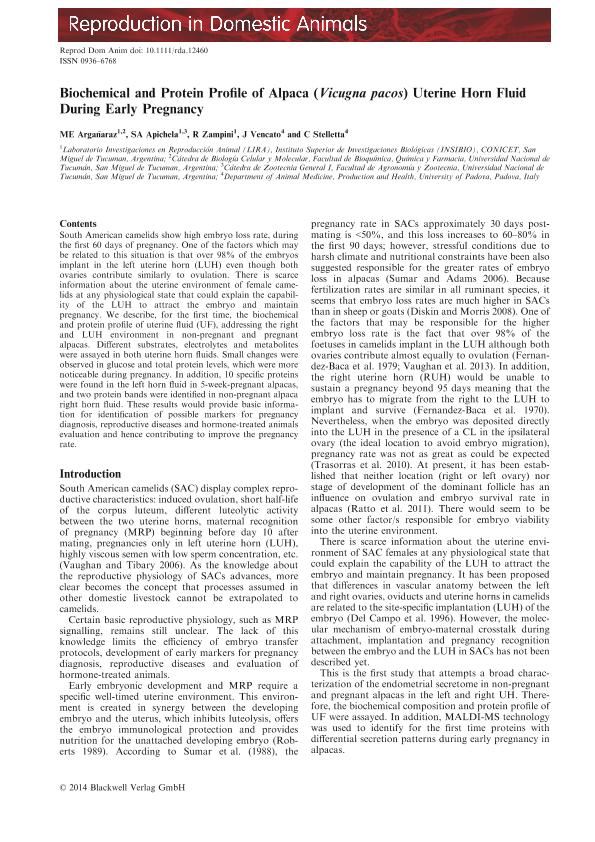Artículo
Biochemical and protein profile of alpaca (vicugna pacos) uterine horn fluid during early pregnancy
Argañaraz, Martin Eduardo ; Apichela, Silvana Andrea
; Apichela, Silvana Andrea ; Zampini, Renato
; Zampini, Renato ; Vencato, Juri; Stelletta, Calogero
; Vencato, Juri; Stelletta, Calogero
 ; Apichela, Silvana Andrea
; Apichela, Silvana Andrea ; Zampini, Renato
; Zampini, Renato ; Vencato, Juri; Stelletta, Calogero
; Vencato, Juri; Stelletta, Calogero
Fecha de publicación:
02/2015
Editorial:
Wiley Blackwell Publishing, Inc
Revista:
Reproduction in Domestic Animals
ISSN:
0936-6768
Idioma:
Inglés
Tipo de recurso:
Artículo publicado
Clasificación temática:
Resumen
South American camelids show high embryo loss rate, during the first 60 days of pregnancy. One of the factors which may be related to this situation is that over 98% of the embryos implant in the left uterine horn (LUH) even though both ovaries contribute similarly to ovulation. There is scarce information about the uterine environment of female camelids at any physiological state that could explain the capability of the LUH to attract the embryo and maintain pregnancy. We describe, for the first time, the biochemical and protein profile of uterine fluid (UF), addressing the right and LUH environment in non-pregnant and pregnant alpacas. Different substrates, electrolytes and metabolites were assayed in both uterine horn fluids. Small changes were observed in glucose and total protein levels, which were more noticeable during pregnancy. In addition, 10 specific proteins were found in the left horn fluid in 5-week-pregnant alpacas, and two protein bands were identified in non-pregnant alpaca right horn fluid. These results would provide basic information for identification of possible markers for pregnancy diagnosis, reproductive diseases and hormone-treated animals evaluation and hence contributing to improve the pregnancy rate.
Palabras clave:
ALPACA
,
UTERUS
,
PREGNANCY
,
UTERINE FLUID
Archivos asociados
Licencia
Identificadores
Colecciones
Articulos(INSIBIO)
Articulos de INST.SUP.DE INVEST.BIOLOGICAS
Articulos de INST.SUP.DE INVEST.BIOLOGICAS
Citación
Argañaraz, Martin Eduardo; Apichela, Silvana Andrea; Zampini, Renato; Vencato, Juri; Stelletta, Calogero; Biochemical and protein profile of alpaca (vicugna pacos) uterine horn fluid during early pregnancy; Wiley Blackwell Publishing, Inc; Reproduction in Domestic Animals; 50; 1; 2-2015; 121-128
Compartir
Altmétricas



